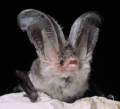Tragus
Tragus (from ancient Greek τράγος tragos ' billy goat') is the anatomical name for the cartilage part of the auricle that forms an elevation in front of the entrance to the external auditory canal ( Meatus acousticus externus ) and often carries a tuft of hair. The growth of this hair, called tragi , resembling a goatee , gave it its name.

In some animals, such as some bat species , the tragus is a functional structure that can be actively moved as an ear cover . In humans, this part of the body is not muscularly mobile. The region of the outer ear , also known as the corner of the ear or billy goat , is also a place for a piercing ( tragus piercing ), with the risk of perichondritis . Opposite the tragus is the antitragus ( opposite corner ) of the auricular cartilage, between the two there is a clear indentation ( incisura inttragica ); Towards the bottom, a cartilage-free earlobe ( lobulus auriculae ) is formed in humans as a differently sized auricle appendage .
The long tragus marks a Sardinian long-eared figure
The red bat has a curved tragus
Next to the antitragus of a house cat is a bag that is used for directional hearing.
Diseases with symptoms of tragus
Inflammation of the outer ear ( otitis externa ) typically triggers tragus pressure pain, as well as pain when the earlobe is pulled gently. In the case of acute otitis media acuta, however, such pressure or tension pain usually does not occur at the beginning of the disease.
In patients with cholesteatoma, the pressure on the tragus is sometimes enough to induce an attack of vertigo.
literature
- Herbert Lippert: Anatomy: Text and Atlas . 5th edition. Urban and Schwarzenberg, 1989.
- Alexander Berghaus, Gerhard Rettinger, Gerhard Böhme: Dual series: ear, nose and throat medicine . Hippokrates Verlag Stuttgart, 1996.


